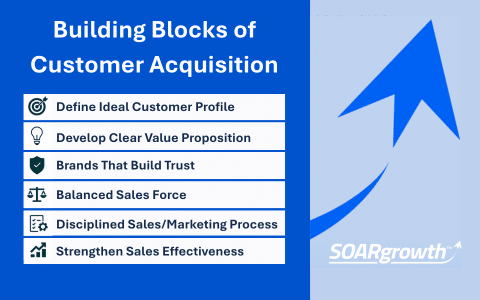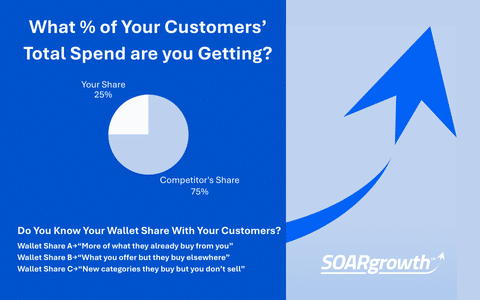By Larry Goddard, Laurence Franklin and Jennifer Goddard
72% of companies say misalignment between strategy and market conditions has slowed their growth in the past three years, according to the Harvard Business Review. If you’re a business leader frustrated by sluggish sales and diminishing returns, you’re not alone. Many companies work tirelessly, grinding through every obstacle in pursuit of growth—only to find themselves stuck in place. Why? Because they’re trying to grow in the wrong market. Instead of battling uphill, it’s time to discover your downhill ride.
The concept of a “downhill ride” may sound like a shortcut, but in truth, it’s a smarter, more strategic way to grow. Downhill rides aren’t about working less—they’re about working in alignment with favorable external conditions like rising demand, higher margins, or underserved customer segments. When your environment supports your momentum, you move faster with less resistance and more efficiency.
Downhill vs. Uphill
Imagine cycling. Pedaling uphill demands brute force, draining your energy. You make progress, but it’s slow and exhausting. Contrast that with a downhill ride—your energy is conserved, the terrain propels you forward, and you gain speed with less effort. Businesses experience the same phenomenon. When companies pursue growth in highly competitive, saturated, or declining markets, they’re fighting an uphill battle. But when they shift to markets or segments where the wind is at their back, success comes more naturally.
Are You Fighting the Wrong Battle?
Many executives don’t realize they’re climbing the wrong hill. They double down on legacy markets, cling to outdated customer bases, or resist necessary pivots. These uphill efforts may be noble—but they are also inefficient and, at worst, unsustainable.
For example, the traditional bicycle market once thrived as a mass transportation solution. But over time, it became saturated and commoditized. Enter e-bikes: by pivoting to meet the needs of urban commuters and eco-conscious consumers, manufacturers discovered a new downhill ride—where demand surged, competition thinned, and margins improved.
Similarly, the camera industry flourished with digital innovation, only to be disrupted by smartphones. Brands like GoPro survived by targeting niche needs—extreme sports and adventure—finding new momentum where traditional players stalled.
In addition, for decades, thermostats were an overlooked commodity—low-margin, utilitarian devices sold largely through hardware stores and bundled with HVAC systems. The market was saturated, undifferentiated, and driven by cost rather than value. That was the uphill ride.
Then came Nest, which reframed the thermostat as a smart, connected, user-friendly product that could reduce energy bills and integrate with modern lifestyles. By targeting tech-savvy homeowners and environmentally conscious consumers, Nest created a downhill ride—a high-growth niche with rising demand, premium pricing, and minimal direct competition at launch.
This repositioning turned a sleepy category into a strategic gateway for smart-home ecosystems. Demand surged, margins improved, and competitors followed.
How to Identify a Downhill Ride
A downhill ride exists at the intersection of four elements:
- Market Demand: Are customer needs growing in this segment?
- Attractive Margins: Can you deliver solutions profitably?
- Underserved Competition: Is the market crowded or relatively open?
- Strategic Fit: Are your capabilities aligned with the opportunity?
If at least two of these factors are favorable—and none are fatal—there may be a downhill ride waiting to be seized.
The Cost of Staying Uphill
Remaining stuck in uphill battles has a real cost. Teams burn out. Leaders lose confidence. Margins shrink, and customer acquisition becomes prohibitively expensive. Worse, organizations risk missing opportunities because they’re too focused on surviving instead of thriving.
We’ve seen mid-market companies stagnate despite exceptional products or talent, simply because their strategies were mismatched with their markets. When we help them identify and pursue downhill rides, their energy—and growth trajectory—changes dramatically.
Finding the Sweet Spot: Strategy in Motion
Finding your downhill ride starts with honest reflection. Map your current position. Where is growth hardest? Where do you see friction or plateauing results? Then look forward. Are there new customer groups, geographies, or offerings where your solution has a natural fit? Could slight modifications reposition your company into a more favorable path?
This isn’t about abandoning your core entirely. Instead, think of it as creating a portfolio of opportunities. You may maintain a profitable uphill core business but augment it with targeted downhill plays to drive new growth and resilience.
Watch Out for Substitutes and Shifts
Even downhill rides aren’t forever. External risks—like regulatory changes, emerging substitutes, or tech disruptions—can flatten or reverse your momentum. That’s why constant market vigilance and scenario planning are essential. Companies that build adaptability into their strategy, that monitor customer behavior and industry trends—are better equipped to shift gears when needed.
The Role of Culture: Smart Work Beats Hard Work
Creating a downhill strategy isn’t just about data—it’s about mindset. Many companies are culturally programmed to equate effort with value. But in today’s volatile market, efficiency, agility, and strategic clarity are more important than sheer hustle.
Businesses that celebrate smart work foster cultures of continuous improvement, where employees feel empowered to challenge the status quo and propose more efficient ways to deliver value. We often see the most transformative change when leaders give teams permission to work smarter—not just harder.
Real-World Lessons
One of our clients—a mid-size manufacturing firm—had spent years competing on price in a crowded market of commodity parts. Margins were tight, and growth was sluggish. When we helped them assess demand trends and customer needs, they uncovered an underserved niche: custom-engineered components for small-run production in a new sector. By reallocating capacity and refining their value proposition, they entered a fast-growing segment with fewer competitors, premium pricing, and long-term customer contracts.
This shift didn’t require massive investment—just a smarter application of insight and strategy. Within a year, they saw double-digit revenue growth, all while reducing customer acquisition costs and improving team morale.
From Struggle to Acceleration: Your Next Step
If your company is straining for growth, it’s time to ask: Are we climbing the right hill? Strategic success lies in choosing your terrain wisely. The market is dynamic. Opportunities come and go. The companies that win are those that are constantly scanning the landscape, ready to pivot when the climb becomes unsustainable.
Downhill rides aren’t accidental—they’re identified, evaluated, and executed. With the right tools and mindset, your business can uncover these opportunities and accelerate with less resistance.
Downhill rides won’t do the work for you—but they’ll make your work more effective. In today’s business climate, that’s the edge that separates the companies who grow effortlessly from those who grind and stall.
If you’re ready to stop pedaling uphill, we specialize in helping businesses uncover their unique path to sustainable, profitable momentum. Your next downhill ride might be closer than you think.
©Copyright, The Parkland Group, Inc. 2025. All rights reserved.



